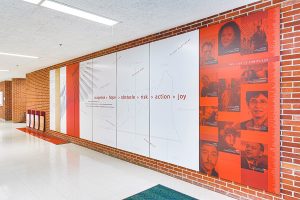Can your building play a role in the education of those who walk through its doors? We believe so – it’s called ambient learning.
Progressive educators recognize that the learning process should not be limited to the classroom and the exchange between teachers and students. In fact, according to a 2013 Gallup State of America’s Schools Report, only 55% of K-12 students are engaged in the traditional learning process.
Introducing experiential graphics into built environments turns the building itself into an educator. Consider a simple example of labeling a drinking fountain in multiple languages with engaging typography. Not only does this teach one how to say drinking fountain in other languages, it teaches a more subtle value of inclusiveness.
The value of ambient learning is not limited to the education industry. The truth is, every organization is in the business of educating. Businesses educate their employees and customers on their history, their processes, their products. Non-profit organizations educate their volunteers, donors and those they serve. Religious institutions educate their people as well. In fact, historically, churches have done a magnificent job through stained glass and art. Consider that Leonardo DaVinci’s famous “Last Supper” painting was commissioned for the Dominican monastery of Santa Maria delle Grazie.
If a picture is worth a thousand words, what pictures would make a difference in your building? Schedule an appointment to explore what ambient learning could do for you.
See just a few of the examples of ambient learning we developed for Delta College below.







